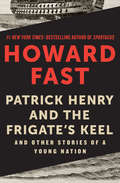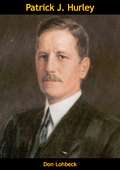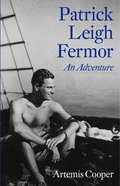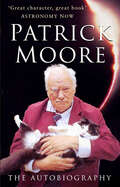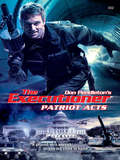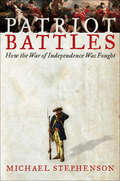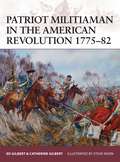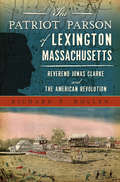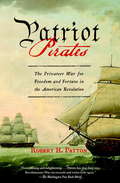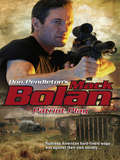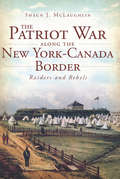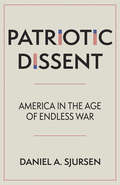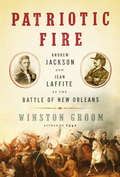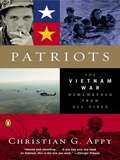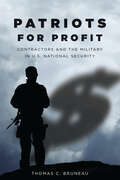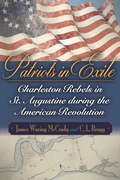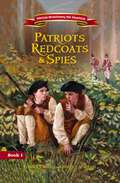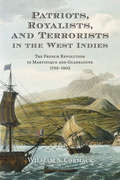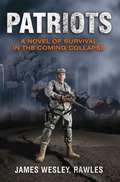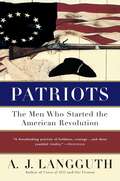- Table View
- List View
Patrick Henry and the Frigate's Keel: And Other Stories of a Young Nation
by Howard FastTwelve tales of the United States&’ early days, capturing moments in the lives of great leaders and farmers alike, all dreaming of the nation to comeWritten mostly while the United States was engaged in World War II, these patriotic stories imagine the best of the American spirit during its formative years. From &“The Day of Victory,&” about a victorious George Washington meeting with his generals one last time to swap stories before they all return to civilian life, to &“The Bookman,&” about a tragic day during the Revolutionary War as experienced by a young boy, each story depicts common citizens standing against tyranny, and settlers searching for a better life. Passionate and beautifully written, Patrick Henry and the Frigate&’s Keel is one of Howard Fast&’s best story collections, and a moving tribute to the aspirations of a new nation. This ebook features an illustrated biography of Howard Fast including rare photos from the author&’s estate.
Patrick J. Hurley
by Don LohbeckFirst published in 1956, this is the biography of Patrick Jay Hurley (1883-1963), a highly decorated American soldier, statesman, and diplomat who served as the U.S. Secretary of War (1929-1933), President Roosevelt’s personal representative in the Near and Middle East (1943), and U.S. ambassador to China (1944-1945). It details the historic events with which Major-General Hurley came in contact; the absorption of the American Indian; the civilizing of the frontier; the Great Depression; the industrialization of the American nation; the Second World War; and, ultimately, his entrance into the contest for world power.A fascinating read.“The life of Patrick J. Hurley is the story of America, the land of opportunity. From the coal fields of the frontier land of Indian Territory, to a foremost place in the cabinet of the President of the United States, to a position as trusted confidant and personal diplomatic representative of the Commander-in-Chief—in his life is brought to fulfillment the American dream that integrity and ability, fortified by hard work and ambition, will receive rewards that no bond of poverty or class can nullify.”—Prologue
Patrick Leigh Fermor: An Adventure
by Artemis CooperPatrick Leigh Fermor's enviably colorful life took off when in 1934, at the age of eighteen, he decided to walk across Europe. In just over a year he had trekked through nine countries and taught himself three languages, and his enthusiasm and curiosity for every kind of experience made him equally happy in caves or country houses, among shepherds or countesses. At the outbreak of war he left his lover, Princess Balasha Cantacuzene, in Romania and returned to England to enlist. Commissioned into the Intelligence Corps, he became one of the handful of Allied officers supporting the Cretan resistance to the German occupation. In 1944 he commanded the Anglo-Cretan team that abducted General Heinrich Kreipe and spirited him away to Egypt. A journey to the Caribbean, stays in monasteries, and explorations all over Greece provided the subjects for his first books. It was not until he and his wife had moved to southern Greece that he returned to his earliest walk. In these books, which took many years to write, he created a vision of a prewar Europe, which in its beauty and abundance has never been equaled. Artemis Cooper has drawn on years of interviews and conversations with Leigh Fermor and his closest friends, and has had complete access to his archive. Her beautifully crafted biography portrays a man of extraordinary gifts--no one wore their learning so playfully nor inspired such passionate friendship.
Patrick McLanahan Collection #2
by Dale BrownIncludes: <P> Rogue Forces: A riveting and relentlessly exciting thriller, Rogue Forces explores a timely and important question in this age of Blackwell and Halliburton: What would happen if the Army’s private security contractors became uncontrollably powerful? Brown’s popular character, Patrick McLanahan, is going Rogue in this chillingly plausible adventure that further solidifies Dale Brown’s reputation as “the best military writer in the country”<P> Executive Intent: With a president battling for his political life in D.C., retired Air Force Lieutenant General Patrick McLanahan and Kai Raydon, commander of the U.S. Space Defense Force, race to defuse the crisis—as every second brings the world closer to a full-scale war of superpowers on Earth . . . and miles above it.<P> A Time for Patriots: In the midst of chaos, Patrick McLanahan—hero of Executive Intent, Rogue Forces, and many other previous adventures—must enlist the aid of his son and his fellow citizens to hunt down terrorists any way they can. In A Time for Patriots, Dale Brown brings the battle home!<P> Tiger's Claw: Set in the near future, Tiger’s Claw imagines a scenario in which tensions escalate between an economically powerful China and a United States weakened by a massive economic downfall, bringing the two superpowers to the brink of total destruction. Brown’s popular protagonist, retired Air Force lieutenant-general Patrick McLanahan (of A Time for Patriots, Rogue Forces, and other Brown bestsellers), is back and preparing for the impending apocalyptic clash of men and military technology.
Patrick Moore: The Autobiography
by Patrick MooreThroughout his distinguished career, Patrick Moore has, without a doubt, done more to raise the profile of astronomy among the British public than any other figure in the scientific world. As the presenter of The Sky at Night on BBC television for nearly 50 years he was honored with an OBE in 1968 and a CBE in 1988. In 2001 he was knighted 'for services to the popularisation of science and to broadcasting'. The BBC first aired The Sky at Night in April 1957 and it is now in the record books as the world's longest running TV series with the same presenter. He is also the author of over 60 books on astronomy, all of which, including his autobiography have been written on his 1908 typewriter. Partly thanks to his larger-than-life personality, Sir Patrick's own fame extends far behond astronomical circles. A self-taught musician and talented composer, he has displayed his xylophone-playing skills at the Royal Variety Performance and as a passionate supporter of cricket, he has played for the Lord's Taverners charity cricket team.
Patrick R. Cleburne And The Tactical Employment Of His Division At The Battle Of Chickamauga
by Major Joseph M. Lance III USMCThis study is a historical analysis of Major General Patrick R. Cleburne's Division during the Battle of Chickamauga. Cleburne's Division earned a reputation as one of the best divisions in either army. This reputation also carried with it lofty expectations. This study analyzes how Cleburne's Division performed at Chickamauga and what the effects of its actions were on the overall outcome of the battle.The Battle of Chickamauga has suffered its share of historical neglect. Fought in the forests and mountains of northern Georgia and southeastern Tennessee, the battle has not been immortalized by any stirring fictional works, nor has it inspired any feature films, but the story of the men who fought there is worth studying.Cleburne's Division did not distinguish itself at Chickamauga. It launched a confused, disjointed night attack to close out the first day of the battle, but determined leaders succeed in capturing their objectives. Day two of the battle saw Cleburne's Division attack four hours late. It was quickly repulsed while suffering horrific casualties. While the Confederate left wing routed the Union Army, Cleburne's Division nursed their wounds before finally advancing at sunset, as the Union withdrew from the battlefield.
Patrick's Destiny: A Selection From The Devaney Brothers: Michael And Patrick (The Devaneys #Vol. 4)
by Sherryl Woods#1 New York Times bestselling author Sherryl Woods brings readers the fourth chapter in the classic tales of the Devaney’s… five brothers torn apart in childhood, reunited by love. Previously published in The Devaney Brothers: Michael & Patrick.Devastated by the discovery of a terrible family secret, Patrick Devaney has shut out the world. But enchanting kindergarten teacher Alice Newberry sees the hurt in his eyes and is determined to help Patrick find peace. She knows it will take a lesson in love and forgiveness to coax the brooding fisherman out of hiding. Soon, Patrick begins to hope, but before he can truly claim Alice as his own, he has to face the greatest challenge of his life—his past.The DevaneysBook One: Ryan’s PlaceBook Two: Sean’s ReckoningBook Three: Michael’s DiscoveryBook Four: Patrick’s DestinyBook Five: Daniel’s Desire
Patrimony (Gateway Essentials #308)
by Alan Dean FosterPip and Flinx: Book Thirteen."I know who your father is . . . Gestalt." A stunned Flinx hears these dying words from one of the renegade eugenicists whose experiments with humans twenty-odd years ago shocked the galaxy . . . and spawned Flinx. So Flinx and his minidrag, Pip, venture to Gestalt, an out-of-the-way planet that may supply the key to Flinx's shadowy past and strange powers. Unfortunately for Flinx, Gestalt also hosts a resident bounty hunter who's just learned about the stupendous reward offered for a certain dead redhead. Flinx gets a chance to test his adversary's skills when our hero's skimmer is blasted out of the sky and into a raging river in the middle of nowhere - a nowhere of impassable terrain and ravenous, carnivorous beasts.
Patriot Acts
by Don PendletonA political assassination in Los Angeles leads to a red alert when the gunman then declares war against Washington. Trained by a secret organization within the U. S. government, the sniper is relentless in his quest to make a better America--even if it means killing millions of innocent people along the way. With the free world in jeopardy, Mack Bolan must stop the rogue agent before the man unleashes his plan. But it's going to take more than weapons to win this battle. Armed with the same deadly skills as Bolan, the misguided killer could be the Executioner's ultimate foe.
Patriot Battles: How the War of Independence Was Fought
by Michael Stephenson&“Well-documented, entertaining. . . . This excellent popular history should attract a wide audience with its fresh perspective.&” —Publishers Weekly Drawing on hundreds of specialist sources, contemporary and archival, Patriot Battles is the comprehensive one-volume study of the military aspects of the War of Independence. The first part of the book offers a richly detailed examination of the nuts and bolts of eighteenth-century combat: For example, who fought and what motivated them, whether patriot or redcoat, Hessian or Frenchman? How were they enlisted and trained? How were they clothed and fed? What weapons did they use, and how effective were they? When soldiers became casualties or fell ill, how did medical services deal with them? What roles did loyalists, women, blacks, and Indians play? The second part of the book gives a closer look at the war's greatest battles, with maps provided for each. Which men were involved, and how many? What was the state of their morale and equipment? What parts did terrain and weather play? What were the qualities of the respective commanders, and what tactics did they employ? How many casualties were inflicted? And no less important, how did the soldiers fight? Throughout, many cherished myths are challenged, reputations are reassessed, and long-held assumptions are tested. For all readers, Patriot Battles is one of the most satisfying and illuminating works to be added to the literature on the War of Independence in many years. &“An interesting and easily digestible study appealing to both military-history buffs and general readers.&” —Booklist &“An iconoclastic, provocative study of the Revolutionary War that invalidates a few chestnuts.&” —Kirkus Reviews
Patriot Games And The Hunt For Red October
by Tom ClancyFor the first time in one volume, two action-packed novels of adventure and suspense from Tom Clancy, the unrivalled master of thriller writing. THE HUNT FOR RED OCTOBER: Silently, beneath the chill Atlantic waters, an ultra-secret Soviet submarine, the Red October, is heading west. Captain Marko Ramius is finally putting into action a desperate plan — to defect to the US, taking the Red October with him. The Americans want her. The Soviets want her back. With all-out war only moments away, the superpowers race across the ocean on a terrifying, heart-stopping mission. The most incredible chase in history is on… PATRIOT GAMES: When Jack Ryan foils an Ulster Liberation Army terrorist attack on the Royal Family, his courageous actions not only win him the admiration of an entire nation, they also rouse the enmity and hatred of that nation’s most dangerous men. Now a ULA target himself, Ryan plunges into the murky world of counter-intelligence, where he uncovers connections between the ULA and an international underground network that place him at the forefront of the deadly battle against international terrorism, and pitch him into the most desperate struggle of his life…
Patriot Militiaman in the American Revolution 1775-82
by Steve Noon Ed Gilbert Catherine GilbertThe American Revolution was a momentous conflict, the outcome of which would influence the birth of a nation. Army regulars fought in massive and famous battles from New England to Virginia, but in the South a different kind of warfare was afoot. Local militia, sometimes stiffened by a small core of the Continental Line, played a pivotal role. This lesser-known war ultimately decided the fate of the Revolution by thwarting the British "Southern strategy". In this book, the authors uniquely focus on the history of their own ancestors, who fought for the South Carolina Militia, to show just how effective the irregular forces were in a complex war of raids, ambushes, and pitched battles. The book explores the tactics, equipment, leadership and performance of the opposing Patriot and Rebel forces, bringing to life the vicious struggle in the South.
Patriot Parson of Lexington, Massachusetts, The: Reverend Jonas Clarke and the American Revolution (Military)
by Richard P. KollenOn the night of April 18, 1775, Paul Revere arrived at the parsonage of Reverend Jonas Clarke to deliver a warning to its occupants, including Samuel Adams and John Hancock. The following morning brought the first shots of the American Revolution to a community Clarke inspired to face such a harsh reality. He called on his parish to oppose imperial legislation for years leading up to the war. And as Lexington's minister for half a century, he was central to political, civic and social life there until his death in 1805. Historian Richard P. Kollen reveals the often overlooked story of the man who helped shape the spirit of the American Revolution.
Patriot Pirates: The Privateer War for Freedom and Fortune in the American Revolution
by Robert H. PattonIn this lively narrative history, Robert H. Patton, grandson of the World War II battlefield legend, tells a sweeping tale of courage, capitalism, naval warfare, and international political intrigue set on the high seas during the American Revolution. Patriot Pirates highlights the obscure but pivotal role played by colonial privateers in defeating Britain in the American Revolution. American privateering--essentially legalized piracy--began with a ragtag squadron of New England schooners in 1775. It quickly erupted into a massive seaborne insurgency involving thousands of money-mad patriots plundering Britain's maritime trade throughout Atlantic. Patton's extensive research brings to life the extraordinary adventures of privateers as they hammered the British economy, infuriated the Royal Navy, and humiliated the crown.
Patriot Play
by Don PendletonBlood Resolve America is under attack from within. Using violence and destruction to throw the population into a panic, a group known as The Brethren, and their political masterminds, are orchestrating anarchy, operating above the law. They have allied themselves with foreign terrorist organizations and are planning a strike to make themselves heard, and to spearhead a direct collision with the U. S. Administration. With federal agencies at a standstill, a determined President needs a direct, no-mercy solution, one prepared to deal with the enemy on the enemy's terms. Mack Bolan is ready and willing to declare war. Partnered with Able Team's leader Carl Lyons, Bolan returns fi re on a relentless search-and-destroy mission against an organization driven by warped ideology to claim absolute power.
Patriot War Along the New York-Canada Border, The: Raiders And Rebels (War Era And Military Ser.)
by Shaun J. MclaughlinDuring the Patriot War, fought between 1837-1842, hundreds of men on both sides of the New York-Canadian border took up arms to free Canada from supposed British tyranny. Infused with the Spirit of '76 and inspired by the recent Texas revolution, they fought bravely in battles, skirmishes and attacks, including November's Battle of the Windmill. Many sacrificed their lives, while others became slave laborers of the British in Tasmania. Among their leaders was Bill Johnston, a Thousand Islands smuggler, river pirate and War-of-1812 privateer, whose cunning was so feared by the British that they called out their military whenever his name made the newspapers. This book recalls the stories, triumphs and sacrifices of the brave on both sides of the border.
Patriotic Dissent: America in the Age of Endless War
by Daniel A. SjursenThis incendiary work by Danny Sjursen is a personal cry from the heart by a once model U.S. Army officer and West Point graduate who became a military dissenter while still on active duty. Set against the backdrop of the terror wars of the last two decades, Sjursen asks whether there is a proper space for patriotism that renounces entitled exceptionalism and narcissistic jingoism. A burgeoning believer and neoconservative, Sjursen calls for a critical exploration of our allegiances, and suggests a path to a new, more complex notion of patriotism. Equal parts somber and idealistic, this is a story about what it means to be an American in the midst of perpetual war, and what the future of patriotism might look like.
Patriotic Fire: Andrew Jackson And Jean Laffite At The Battle Of New Orleans (Playaway Adult Nonfiction Ser.)
by Winston GroomGroom recounts the Battle of New Orleans, in which Andrew Jackson joined French pirate Jean Lafitte to fight against the British invasion of the city in December of 1814. He discusses what led up to the battle, its stages, Jackson's and the British strategy, and how the British tried to recruit Lafitte. Groom is the author of 13 other books on historical and fictional subjects, including Forrest Gump, and was nominated for a 1984 Pulitzer Prize. Annotation ©2006 Book News, Inc. , Portland, OR (booknews. com)
Patriots
by Appy Christian G.Christian G. Appy?s monumental oral history of the Vietnam War is the first work to probe the war?s path through both the United States and Vietnam. These vivid testimonies of 135 men and women span the entire history of the Vietnam conflict, from its murky origins in the 1940s to the chaotic fall of Saigon in 1975. Sometimes detached and reflective, often raw and emotional, they allow us to see and feel what this war meant to people literally on all sides?Americans and Vietnamese, generals and grunts, policymakers and protesters, guerrillas and CIA operatives, pilots and doctors, artists and journalists, and a variety of ordinary citizens whose lives were swept up in a cataclysm that killed three million people. By turns harrowing, inspiring, and revelatory, Patriots is not a chronicle of facts and figures but a vivid human history of the war. .
Patriots for Profit: Contractors and the Military in U. S. National Security
by Thomas C. BruneauThis book develops a new approach to the analysis of civil-military relations by focusing on the effectiveness of the armed forces in fulfilling roles & missions, and on their efficiency in terms of cost. The approach is applied to the United States using official documents and interviews with policy-makers. In addition to analyzing the impact of defense reform initiatives over the past thirty years, the book includes the recent phenomenon of "contracting-out" security that has resulted in greater numbers of contractors in Iraq and Afghanistan than uniformed military personnel. While the book demonstrates that democratic civilian control of the military in the U. S. is not at issue, it reveals that there is little public control over Private Security Contractors due to a combination of the current restricted interpretation of what is an "inherently governmental function" and limited legal authority. This is despite the fact that PSCs have taken on roles and missions that were previously the responsibility of the uniformed military. Further, despite numerous efforts to redress the problem, current political and institutional barriers to reform are not likely to be overcome soon.
Patriots in Exile: Charleston Rebels in St. Augustine during the American Revolution
by James Waring McCrady C. L. BraggA historical study of a little-known episode of the American Revolution in which Charleston residents were held in a British-occupied region of Florida.In the months following the May 1780 capture of Charleston, South Carolina, by combined British and loyalist forces, British soldiers arrested sixty-three Americans and transported them to the borderland town of St. Augustine, East Florida—territory under British control since the French and Indian War. In Patriots in Exile, James Waring McCrady and C. L. Bragg chronicle the banishment of these southerners, the hardships endured by their families, and the plight of the enslaved men and women who accompanied them.McCrady and Bragg examine the events from various perspectives, including the British who governed occupied Charleston, the families left behind, the armies in the field, the Continental Congress, and finally the Jacksonboro Assembly of January and February 1782. Using primary sources and archival materials, the authors develop biographical sketches of each exile and illuminate important facets of the American Revolution’s southern theater. While they shared a common fate, the exiles were a diverse lot of tradesmen, artisans, prominent civilians, military officers, and others—among them three signers of the Declaration of Independence. Although they had clear socioeconomic differences, most were unrepentant patriots forced to navigate complex and dangerous circumstances.
Patriots, Redcoats and Spies (American Revolutionary War Adventures)
by Robert J. SkeadWhen their father is injured, twins John and Ambrose must deliver a crucial secret message to General George Washington, facing danger from both the war raging around them and a British soldier who is hot on their trail. Based on the real Culper Spy Ring, book one of the American Revolutionary War Adventures historical fiction series is a fun way for children to experience American history.When their patriot father is shot by British soldiers while on a mission for the Continental Army, it falls to 14-year-old twins John and Ambrose to deliver the secret message their dad was carrying to General George Washington. As the boys set off from Connecticut to New Jersey to find General Washington, they discover the road to the commander-in-chief of the Continental Army is full of obstacles—including the redcoat who shot their father and who is determined to stop the message no matter what.In addition to bringing to life America's war for independence, including information on the Culper Spy Ring that helped turn the war for the Colonies, Patriots, Redcoats, and Spies:Teaches children about the Revolutionary War from a kid's perspectiveIs packed with historical information that is entertaining and educationalContains discussion questions, backgrounds on the real-life historical persons featured in the book, and a glossary of key termsCan be used alongside school curriculum and as a homeschool resourceAmerican Revolutionary War Adventures:Are great for young readers ages 8-12 who like historyAre a fictionalized stories from history inspired by real events and peopleAre perfect for back to school or summer reading challengesMake a great gift for Christmas, holidays, birthdays, or other gift-giving occasions
Patriots, Royalists, and Terrorists in the West Indies: The French Revolution in Martinique and Guadeloupe, 1789-1802
by William CormackPatriots, Royalists, and Terrorists in the West Indies examines the complex revolutionary struggle in Martinique and Guadeloupe from 1789 to 1802. The arrival of tricolour cockades – a badge symbol of the French Revolution – and news from Paris in 1789 undermined the royal governors’ authority, unleashed bitter conflict between white factions, and encouraged the aspirations of free people of colour to equality and black slaves to freedom. This book provides a detailed narrative of the shifting political developments, and analyses the roles of planter resentment of metropolitan control, social and racial tensions, and the ambiguity of revolutionary principles in a colonial setting. Recent scholarship has tended to over-emphasize the colonies’ agency, and to accentuate the conflict between masters and slaves, while downplaying metropolitan influences. In contrast, this study seeks to restore the importance of destabilizing political struggles between white factions. It argues that metropolitan news, ideas, language, and political culture: the "revolutionary script" from France; played a key role in shaping the revolution in the colonies.
Patriots: A Novel of Survival in the Coming Collapse
by James Wesley RawlesA fast-paced thriller that follows a group of Christian survivalists through a stock market crash, an economic collapse, and a second civil war. "Patriots" doesn't just tell what could happen in the near future, it explains exactly how to prepare for such a disaster.
Patriots: The Men Who Started the American Revolution
by A. J. LangguthThe story of the Americn Revolution told through biographies focusing on specific individuals.
